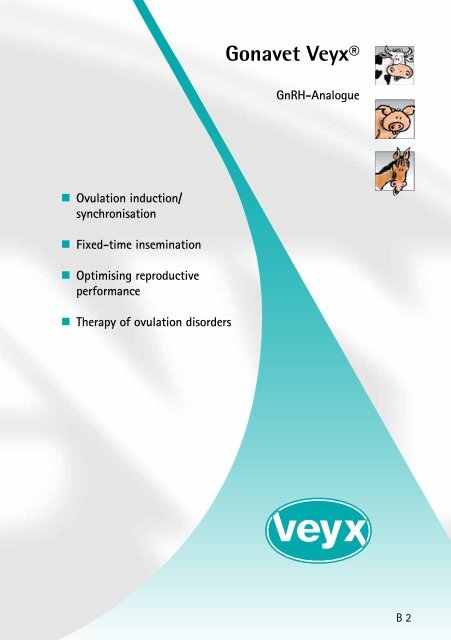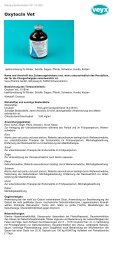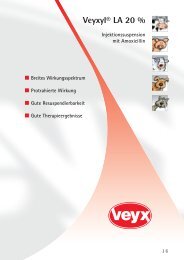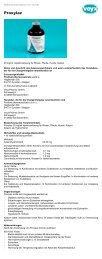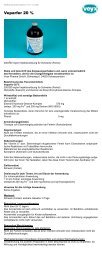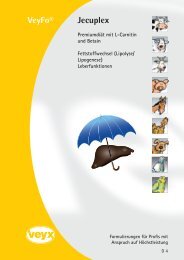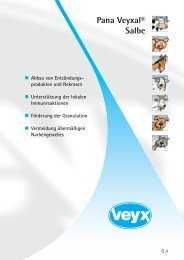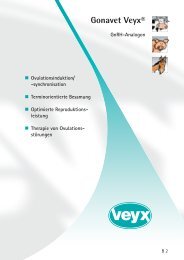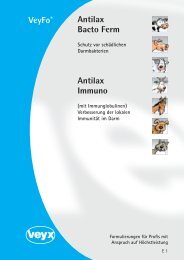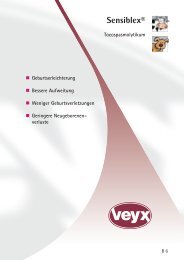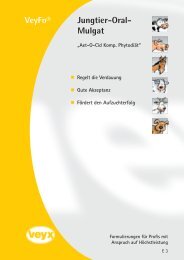Veyxyl® Tabs Gonavet Veyx® - Veyx-Pharma GmbH
Veyxyl® Tabs Gonavet Veyx® - Veyx-Pharma GmbH
Veyxyl® Tabs Gonavet Veyx® - Veyx-Pharma GmbH
Create successful ePaper yourself
Turn your PDF publications into a flip-book with our unique Google optimized e-Paper software.
<strong>Gonavet</strong> <strong><strong>Veyx</strong>yl®</strong> <strong><strong>Veyx</strong>®</strong> <strong>Tabs</strong><br />
GnRH-Analogue<br />
Antipyretikum/<br />
Antiphlogistikum<br />
• Ovulation Infektionen induction/ des Endometriums<br />
synchronisation<br />
Nachgeburtsverhaltung<br />
• Fixed-time insemination<br />
• Optimising reproductive<br />
performance<br />
• Therapy of ovulation disorders<br />
B 2<br />
J 7
Gonadorelin[6-D-Phe] contained in the product <strong>Gonavet</strong> <strong><strong>Veyx</strong>®</strong> is a synthetic derivative<br />
of the gonadotropin releasing hormone GnRH which develops naturally in the<br />
hypothalamus. Gonadorelin[6-D-Phe] triggers the same neuroregulatory and endocrinal<br />
processes as the original GnRH. Thus, it induces the synthesis and release of<br />
the ovary regulating gonadotropic hormones LH and in a smaller amount FSH. These<br />
gonadotropins in turn stimulate follicular maturation, ovulation and the formation<br />
of the corpora lutea.<br />
In comparison to the original GnRH, Gonadorelin[6-D-Phe] is characterised by a longer<br />
duration of action and a much greater affinity to the GnRH receptors in the pituitary<br />
gland. It also shows greater resistance to peptidases. The result is that <strong>Gonavet</strong><br />
<strong><strong>Veyx</strong>®</strong> shows approximately ten times the level of efficacy to that of natural GnRH.<br />
Instructions for use<br />
<strong>Gonavet</strong> <strong><strong>Veyx</strong>®</strong>, 50 µg/ml, injection solution for cattle, pigs and horses<br />
Gonadorelin[6-D-Phe]<br />
Active substance and other ingredients<br />
Active substance:<br />
Gonadorelin[6-D-Phe]<br />
50.0 µg/ml<br />
(equivates to 52.4 µg/ml Gonadorelin[6-D-Phe]acetate)<br />
2
Other ingredients knowledge of which is essential for proper administration of the<br />
veterinary medicinal product:<br />
Chlorocresol 1.0 mg/ml<br />
Indications<br />
Control and induction procedures in the reproduction of cattle and pigs. Therapy<br />
of ovarian derived fertility disorders and malfunction of the reproductive system in<br />
cattle and horses.<br />
Cattle:<br />
– Ovulation induction in case of delayed ovulation resulting from an LH deficiency.<br />
– Ovulation induction/synchronisation as a part of a fixed-time insemination programme.<br />
– Stimulation of the ovaries in the puerperium from the 12 th day post-partum<br />
– Ovarian cysts (as a result of LH deficiency)<br />
Pigs:<br />
Ovulation induction/synchronisation within the programme of fixed-time insemination<br />
and synchronised farrowing.<br />
Horses:<br />
Central LH deficit derived insufficiency of the oestrous cycle (anoestrus, acyclic<br />
oestrus)<br />
Contraindications<br />
Administration from the 12 th day after calving in cows with ovulation ripe tertiary<br />
follicles. Infectious diseases and other significant disorders of the health status.<br />
Adverse reactions<br />
Cycle disorders.<br />
If you notice any serious effects or other effects not mentioned in this leaflet, please<br />
inform your veterinary surgeon or pharmacist.<br />
Target species<br />
Cattle, pigs, horses<br />
3
Dosage for each species, routes and method of administration<br />
Details as ml <strong>Gonavet</strong> <strong><strong>Veyx</strong>®</strong> per animal<br />
Cattle:<br />
– Ovulation induction in case of delayed ovulation due to<br />
LH deficiency<br />
2.0 ml i.m.<br />
– Ovulation induction/synchronisation within the scope<br />
of a fixed-time insemination programme<br />
1.0 ml i.m.<br />
– Ovarian stimulation in puerperium from day 12 post-partum 1.0 ml i.m.<br />
– Ovarian cysts (as a result of LH deficiency) 2.0 ml i.m.<br />
Pigs:<br />
– Adult sows 0.5 – 1.0 ml i.m. or s.c.<br />
– Gilts 1.0 – 1.5 ml i.m. or s.c.<br />
Mares:<br />
<strong>Gonavet</strong> <strong><strong>Veyx</strong>®</strong> is generally administered once.<br />
Advice on correct administration<br />
Not applicable.<br />
Withdrawal period<br />
Cattle, Horse, Pig: meat and offal 0 days<br />
Cattle, Horse: milk 0 days<br />
2,0 ml i.m.<br />
Special storage precautions<br />
Keep out of the reach and sight of children. Do not store above 25 °C. Protect the<br />
container from light in the outer carton. Shelf-life after first opening the container:<br />
28 days. Once this time limit has been exceeded any medicine residues must be<br />
discarded. Do not use after the expiry date which is stated on the label and the outer<br />
carton.<br />
Special warnings<br />
Special warnings for each target species<br />
None.<br />
Special precautions for use<br />
Special precautions for use in animals<br />
Not applicable.<br />
Special precautions to be taken by the person administering the veterinary medicinal<br />
product to animals:<br />
This product must be handled carefully to avoid accidental self-injection. In case of<br />
accidental self-injection, seek medical advice and show the package leaflet to the<br />
4
doctor. Accidental spillage on the skin or into the eyes should be washed off immediately<br />
with plenty of water. Pregnant women should not handle the product. Users<br />
with a known sensitivity to GnRH should not administer the preparation.<br />
Use during pregnancy, lactation or lay<br />
In case of erroneous use during pregnancy no negative consequences for its further<br />
course or foetal development are to be expected. <strong>Gonavet</strong> <strong><strong>Veyx</strong>®</strong> should be given to<br />
sows after weaning off the piglets. Administration in lactating cows and mares must<br />
be carried out correctly.<br />
Interaction with other medicinal products and other forms of interaction<br />
Synergistic effects occur when used combined with FSH, especially in case of a<br />
disturbed course of the puerperium. Simultaneous application of human or equine<br />
chorionic gonadotropin can lead to overreaction of the ovaries.<br />
Overdoses (symptoms, emergency procedures, antidotes), if necessary<br />
Not applicable.<br />
Incompatibilities<br />
Not applicable.<br />
Special precautions for the disposal of unused product or waste materials, if any<br />
Any unused veterinary medicinal product or waste materials derived from such veterinary<br />
medicinal product should be disposed of in accordance with local requirements.<br />
Ask your veterinary surgeon how to dispose of medicines no longer required.<br />
To be applied only on veterinary prescription.<br />
Package sizes<br />
10 ml, 20 ml and 50 ml vial<br />
6 vials at 10 ml<br />
Physiological basis<br />
The reproductive process in mammals is an extraordinarily complex controlled biological<br />
procedure. The central nervous system (CNS) and especially the hypothalamus<br />
play a decisive role. Neural structures have a primary influence, formed by<br />
the hypothalamus and its synaptic connections to the forebrain and midbrain and<br />
known as the limbic system. Thus the hypothalamus is an intermediary between the<br />
central nervous system and the endocrine system. It receives and transmits both the<br />
environmental stimuli received via the cerebral cortex and signals from the animal<br />
body (Fig. 1).<br />
5
Cortex<br />
Corpus callosum<br />
Olfactory,<br />
acoustic,<br />
thermal and<br />
other stimuli<br />
Cerebral epiphysis<br />
Cerebellum<br />
Mesencephalon<br />
Olfactory<br />
Neurohypophysis<br />
bulb<br />
Adeno-<br />
Parts of the limbic system<br />
Mediobasal hypothalamus<br />
Area praeoptica<br />
Fig. 1:<br />
Schematic depiction of the limbic system and the central nervous structures,<br />
also, control of reproductive functions (acc. to BUSCH 1991b)<br />
DHPC = dorsal hippocampus; ST = Stria terminalis; AP = Area praeoptica; NVMH = Nucleus<br />
ventromedialis hypothalami; NPV = Nucleus paraventricularis; NARC = Nucleus arcuatus; NSO<br />
= Nucleus supraopticus; NM = Nucleus mamillaris; NSCH = Nucleus suprachiasmaticus; AMY =<br />
Amygdala; VHPC = ventral hippocampus<br />
Additional components of a functional reproductive cycle are the gonads and the<br />
genital tract. The participating neural and humoral stages are organised hierarchically,<br />
however, the functions of the higher order organs are influenced by the subordinate<br />
organs.<br />
The closely related interchange connections of this regulatory process are shown in<br />
Figure 2 and encompass:<br />
– extra-hypothalamic structures of the central nervous system that exert influence<br />
on the secretion of GnRH (Gonadotropin-Releasing-Hormone), through exogenous<br />
and endogenous stimuli via the mediation of neurotransmitters, peptides<br />
and prostaglandins.<br />
– the hypothalamus, as the fundamental site of production of GnRH<br />
– the adenohypophysis with the production of FSH (Follicle stimulating hormone)<br />
and LH (Luteinising hormone), as well as prolactin<br />
– the ovary as the target organ of the gonadotropins (FSH, LH) and production site<br />
of oestrogens, androgens, gestagens and folliculostatin<br />
– the uterus, on the one hand presented as an important effector organ of the ovarian<br />
hormones and on the other, where it exerts an immediate influence on the<br />
ovarian cycle via PGF 2a<br />
(Prostaglandin F 2a<br />
).<br />
6
Exogenous stimuli<br />
CENTRAL NERVOUS SYSTEM<br />
Neurotransmitters Peptides Prostaglandins<br />
HYPOTHALAMUS<br />
ADENOHYPOPHYSIS<br />
Growth<br />
of follicles<br />
OVARY<br />
Ovulation<br />
Luteinization<br />
Ovarian steroids<br />
(Oestrogens,<br />
Progesterone)<br />
positive Feedback<br />
negative Feedback<br />
UTERUS<br />
Fig. 2: Physiological control of reproduction in female animals (after DÖCKE 1994,<br />
simplified depiction)<br />
GnRH is a key substance in the control of female sexual function. The neuro-hormone<br />
also known as gonadoliberin, luliberin or luteinising-hormone-releasing-hormone<br />
(LHRH) was initially detected in the rat in 1960 by McCANN’s work group. GnRH<br />
is formed by hypothalamic neurons in all domestic mammals and undergoes pulsatile<br />
release. It reaches the pituitary via a special vascular system (hypothalamohypophysial-portal<br />
system). There, the formation and release of LH and in limited<br />
quantities also FSH is stimulated by GnRH.<br />
The released gonadotropins reach the ovaries via the blood circulation and there<br />
stimulate the growth of the follicle and ripening of the egg cell(s). The formation of<br />
gonadotropin receptors in the follicular epithelium is induced, which in turn initiates<br />
ovarian steroid synthesis. In this way the production of oestrogen is controlled<br />
by FSH. In turn an elevated blood progesterone level reduces the FSH secretion by<br />
a feedback mechanism. The high oestrogen level induces oestrus and via a positive<br />
feedback the LH-Peak, which leads to the ripening of the follicles and ovulation.<br />
The ovulation inducing LH-Peak is subject to a rapid depletion. In the subsequent<br />
phase the pituitary gland is insensitive to a further stimulation by GnRH. This is especially<br />
significant for the practical application of GnRH for the induction of ovulation,<br />
as in this way, alongside the induction, an additional endogenous LH peak that<br />
could affect the ovarian and hormonal processes can be inhibited.<br />
A corpus luteum (yellow body) develops from the ruptured follicle after ovulation<br />
and produces increasing quantities of progesterone. In non-pregnant animals the<br />
function of the corpus luteum is interrupted through the effects of PGF 2a<br />
. This effects<br />
a morphological regression of the corpus luteum and the progesterone level<br />
7
falls. The reduction in progesterone effect then results once again in an increased<br />
release of FSH, achieving the prerequisites for a new oestrous cycle to commence.<br />
Further GnRH effects are found in the body organism, in addition to the stimulating<br />
effect on the pituitary gland gonadotropin secretion described here. This includes<br />
the increased level of sexual behaviour, which is probably induced via extra-hypothalamic<br />
areas of the brain. Moreover, GnRH may also affect the gonads directly,<br />
i.e. without mediation by gonadotropins. In female animals a primarily promoting<br />
influence on egg cell maturation, luteinising and the synthesis of progesterone in<br />
the granulosa cells of mature follicles has been observed.<br />
Cognisance of the aforementioned relationships allow for various effects to be<br />
achieved through the administration of GnRH in cycling animals. For example, a<br />
single injection of GnRH at higher dosage rates induces the release of the ovulation<br />
triggering LH.<br />
Chemistry<br />
<strong>Gonavet</strong> <strong><strong>Veyx</strong>®</strong> contains a synthetic derivative of the physiological gonadotropin releasing<br />
hormone GnRH. The chemistry involves a D-Phe 6 -LHRH (D-Phe 6 -Luteinising-<br />
Hormone-Releasing-Hormone, Gonadorelin[6-D-Phe]), a highly effective peptide<br />
hormone (decapeptide) with the chemical formula<br />
C 62<br />
H 80<br />
N 17<br />
O 13<br />
• x CH 3<br />
COOH (x = 1 to 2)<br />
and a molar mass of 1271.4 g/mol (acetate free substance) along with the sequence:<br />
PyroGlu-His-Trp-Ser-Tyr-D-Phe-Leu-Arg-Pro-GlyNH 2<br />
The difference between the natural GnRH and the synthetic derivate is based on<br />
the fact that glycine has been substituted by D-Phenylalanine at position 6 of the<br />
amino acid sequence. In this way GnRH analogues are formed (GnRH-agonists) that<br />
are characterised by a long acting efficacy and a significantly higher affinity to the<br />
GnRH receptors of the pituitary gland. Moreover, they also exhibit a higher resistance<br />
to peptidases. This results in around a ten-fold more intensive effect for <strong>Gonavet</strong><br />
<strong><strong>Veyx</strong>®</strong> in comparison to natural GnRH. The <strong>Gonavet</strong> <strong><strong>Veyx</strong>®</strong> preparation is a clear,<br />
almost colourless, aqueous solution, exhibiting a weak but characteristic acetic acid<br />
odour and has a pH value between 5.0 and 6.0.<br />
8
<strong>Pharma</strong>cology<br />
The effect of the Gonadorelin[6-D-Phe] contained in <strong>Gonavet</strong> <strong><strong>Veyx</strong>®</strong> corresponds to<br />
that of the natural endogenous GnRH, whereby the intensity and duration of action<br />
in the synthetic analogue exhibit a considerable increase. Gonadorelin[6-D-Phe]<br />
stimulates to a large extent the synthesis and especially the release of gonadotropins<br />
from the pituitary gland. Thereby, the increase of the LH level in blood plasma<br />
following the application of <strong>Gonavet</strong> <strong><strong>Veyx</strong>®</strong> is particularly noticeable. The LH peak<br />
occurring in a spontaneous cycle is imitated and effects all the physiological reactions<br />
involved with the follicle maturation and ovulation.<br />
The exogenously given <strong>Gonavet</strong> <strong><strong>Veyx</strong>®</strong> in prooestrus or early oestrus is effective on<br />
the gonadotropin forming cells of the adenohypophysis. In these stages of the cycle,<br />
the disposition for reactivity by the pituitary gland and the ovary is particularly high.<br />
The release of LH commences immediately after the injection and develops into an<br />
LH peak within 1 to 2 hours. The initial values are only to be found again after about<br />
7 to 8 hours.<br />
The single exogenous supply of <strong>Gonavet</strong> <strong><strong>Veyx</strong>®</strong> leads to a transitional release of LH.<br />
A simultaneously high GnRH level is physiologically abnormal and effects a desensitising<br />
of the gonadotropic cells as a result of a decline of GnRH receptors in the cell<br />
membrane. As a consequence, the release of Gonadotropins fails to occur.<br />
In figure 3 the LH profile of cows with a disturbed course of the puerperium is shown<br />
following a single application of 1 ml <strong>Gonavet</strong> <strong><strong>Veyx</strong>®</strong>.<br />
Gonadorelin[6-D-Phe]<br />
Gonadorelin<br />
[6-D-Phe]<br />
Animal 3 (5 th Tag p.p.)<br />
Animal 2 (8 th Tag p.p.)<br />
Animal 1 (7 th Tag p.p.)<br />
Hours after injection<br />
Animal 5 (14 th Tag p.p.)<br />
Animal 4 (12 th Tag p.p.)<br />
Hours after injection<br />
Fig. 3:<br />
LH blood level following a single application of 50 µg Gonadorelin<br />
[6-D-Phe] at differing times in the puerperium (BUSCH 1986)<br />
Based on this <strong>Gonavet</strong> <strong><strong>Veyx</strong>®</strong> has the ability to release LH from the adenohypophysis<br />
and to induce a characteristic LH progression curve in the blood plasma from already<br />
5 days post-partum (BUSCH 1986). The peak value of the induced LH blood level<br />
values relates principally to the state of the individual neuro-endocrine development<br />
of the animal. Therefore, for example in the cow the necessity is underlined that,<br />
for a stimulation of ovarian activity during the puerperium, if possible only those<br />
animals are selected that have a defective development of the follicles. Otherwise it<br />
9
is to be reckoned with that the 1st ovulation p. p. will be induced prematurely and<br />
to a large extent independent of the dosage of the applied preparation.<br />
Gonadorelin[6-D-Phe] stands out as having a very good tolerance level. It has low<br />
toxicity. The estimated LD 50<br />
following intravenous administration was 15.4 mg/kg<br />
live weight in rats. For the subacute toxicity tests (28 day application duration) in<br />
rats showed that <strong>Gonavet</strong> <strong><strong>Veyx</strong>®</strong> was harmless at application levels that corresponded<br />
to 50 times the therapeutic dosage. Gonadorelin[6-D-Phe] is completely metabolised<br />
within 10 hours following the injection. Intoxications cannot be achieved<br />
with the active substance, however, it has to be dosed precisely in the interests of<br />
achieving a timed and precise determinable effect.<br />
Gonadorelin[6-D-Phe] is considered harmless from a biological residue persepective.<br />
The breakdown and inactivation of GnRH takes place very rapidly, so that its biological<br />
half-life is very short. For example in heifers, five minutes after an intravenous<br />
injection of 2.5 mg GnRH the highest blood level was attained and after 1.5 hours<br />
the initial level was already achieved. Excretion of the metabolites occurs primarily<br />
via the kidneys. Therefore, there is no requirement for a withdrawal period.<br />
<strong>Pharma</strong>cotherapy<br />
Application in cattle<br />
<strong>Gonavet</strong> <strong><strong>Veyx</strong>®</strong> enables an effective therapy and prophylaxis for various disorders of<br />
the reproductive process in cattle. A significant improvement in the pregnancy rates,<br />
a reduction in the need for sterility treatments and low culling selection rates due to<br />
inability to breed are all confirmed in many scientific studies.<br />
The tolerance to and efficacy of <strong>Gonavet</strong> <strong><strong>Veyx</strong>®</strong> was determined and tested using<br />
around 2,900 cattle for indications with a very diverse range of diagnostic or therapeutic<br />
aspects. In contrast, about 1,800 control animals were used, i.e. cows that<br />
were kept under the same conditions and were not treated at all or given original<br />
GnRH.<br />
1. Therapy of ovulation disorders<br />
The secretion of LH induced by a single application of <strong>Gonavet</strong> <strong><strong>Veyx</strong>®</strong> can be used to<br />
induce ovulation in cattle, insofar as a tertiary follicle exists on one of the ovaries.<br />
Disorders such as delayed ovulation and ovarian cysts that touch upon no timely<br />
release of LH or an LH deficiency, are thus indications for <strong>Gonavet</strong> <strong><strong>Veyx</strong>®</strong>.<br />
Delayed ovulation<br />
In cattle the rupturing of the follicle is to be considered as delayed when it does not<br />
occur within 6 to 16 hours following the ending of standing oestrus. The significance<br />
of delayed ovulation as a factor that reduces fertility is based on the fact that at<br />
the time of possible amphimixis, either the egg cell or the sperm are damaged or<br />
already dead.<br />
10
In many scientific studies, cows with delayed ovulation had a 12 to 15 % and significant<br />
increase in pregnancy rate determined following an application of <strong>Gonavet</strong><br />
<strong><strong>Veyx</strong>®</strong> in comparison to untreated control animals.<br />
Where a delayed ovulation is diagnosed or suspected, then a double insemination is<br />
advisable (1 st insemination in the 2 nd half of oestrus, 2 nd insemination 24 hours later).<br />
The application of <strong>Gonavet</strong> <strong><strong>Veyx</strong>®</strong> should if possible, be given at the same time as<br />
the first insemination, but at the latest at the same time as the second insemination.<br />
Ovarian cysts<br />
The efficiency of cyst treatment using <strong>Gonavet</strong> <strong><strong>Veyx</strong>®</strong> has been determined in comprehensive<br />
clinical investigations. This showed that 60 % of the cows (n = 250) treated<br />
with the preparation were already in-calf to the first insemination. The overall<br />
pregnancy rate was about 80 %. Recidive cysts were observed in 11 % of the animals.<br />
The interval between the cyst treatment and the first AI (Artificial insemination)<br />
lay at 28.7 days. The interval between the treatment and pregnancy diagnosis<br />
was on average 48.3 days.<br />
The Ovsynch procedure described in Section 3 has also proven successful for the<br />
therapy of ovarian cysts.<br />
The fertility of the ovulated egg cells in the oestrus induced by the hormone treatment<br />
is significantly reduced. Thus the treated animal should be inseminated in the<br />
subsequent oestrus, i.e. 3 weeks later. Also, when following the treatment using the<br />
Ovsynch procedure, so that the pregnancy rate is comparable to other therapy procedures,<br />
it is an advantage that the majority of the animals remain cyclic.<br />
It is applicable, independent of the therapeutic procedure chosen, for the prospects<br />
for improvement to be so much better the earlier after calving the ovarian cysts are<br />
diagnosed and treated.<br />
2. Stimulation of the ovaries in the puerperium<br />
In a number of studies involving large numbers of animals it was determined that<br />
the prophylactic application of <strong>Gonavet</strong> <strong><strong>Veyx</strong>®</strong> in the clinical puerperium significantly<br />
reduced the frequency of endometritis and reduced the calving interval. The<br />
preparation should be injected 12 days post-partum. At this time the ovaries almost<br />
always exhibit an LH responsive follicle. It has proven effective to carry out a PGF 2a<br />
injection seven days after the application in order to induce a second oestrus. The<br />
treatment should ensure that a cyclic ovarian activity commences early in the puerperium.<br />
If the cycle has begun in the animals, then in most cases oestrus will occur at<br />
regular intervals. The insemination can then be carried out at the end of the planned<br />
calving to first insemination interval.<br />
3. Ovulation synchronisation<br />
Ovulation synchronisation is primarily suitable for units with problems with oestrus<br />
detection and low oestrus rates (HEUWIESER and MANSFELD 1999).<br />
11
Ovsynch procedure<br />
The Ovsynch procedure developed in the USA is by far the most widely used method<br />
of ovulation synchronisation in cattle. Animals included in the synchronisation procedure<br />
are initially administered a GnRH preparation, e.g. <strong>Gonavet</strong> <strong><strong>Veyx</strong>®</strong>. They are<br />
given PGF 2a<br />
e.g. PGF <strong><strong>Veyx</strong>®</strong> forte seven days later. Two days (30 - 48 hours) after the<br />
PGF 2a<br />
treatment, a second GnRH application is carried out. The animals involved<br />
can then be inseminated at a ‚fixed-time‘ without any preceding oestrus detection<br />
8 - 24 hours later. (Fig. 4). However, it is the opinion of some authors that carrying<br />
out oestrus detection is to be recommended, as where an oestrus commences after<br />
the first injection, all subsequent injections can be avoided. Moreover, the timing of<br />
oestrus detection can be planned when using the Ovsynch procedure.<br />
Tag 0<br />
First injection of <strong>Gonavet</strong> <strong><strong>Veyx</strong>®</strong><br />
Tag 7<br />
Tag 9<br />
Tag 10<br />
Injection of PGF 2a<br />
Second injection of <strong>Gonavet</strong> <strong><strong>Veyx</strong>®</strong><br />
(30 – 48 h after administration of PGF 2a<br />
)<br />
Insemination without prior oestrus monitoring<br />
(8 – 24 h after the second administration of <strong>Gonavet</strong> <strong><strong>Veyx</strong>®</strong>)<br />
Fig. 4: Ovulation synchronisation with the Ovsynch procedure (acc. to WILTBANK<br />
1998)<br />
The mode of effect touches upon the following (HEUWIESER and MANSFELD 1999):<br />
The first GnRH administration leads to the ovulation of the dominant follicle within<br />
24 - 32 hours and thereby to the formation of a new or an additional corpus luteum.<br />
This is why oestrus occurs only after the first PGF 2a<br />
administration. Within 1 - 2 days<br />
after the GnRH administration there is the development of a new follicle surge. One<br />
of the follicles achieves dominance and can be ovulated following the PGF 2a<br />
induced<br />
luteolysis. The second GnRH administration effects a synchronised ovulation.<br />
Based on various investigations, the success rate for insemination in cows following<br />
the carrying out of the Ovsynch procedure and inseminated using a fixed-time insemination<br />
were only slightly lower than those for the respective control animals<br />
inseminated based on oestrus detection. In all studies published to date, it was<br />
determined consistently that this procedure produces better results in cows than<br />
in heifers.<br />
It is recommended, when applying the Ovsynch procedure, that all animals to be<br />
synchronised undergo a gynaecological examination, in order to detect patients<br />
12
with pathological conditions of the reproductive organs and to exclude or treat<br />
them prior to synchronisation. SOBIRAJ and PRESCHE (1999) recommend that the<br />
Ovsynch procedure is carried out under veterinary supervision when they have not<br />
been detected as being in oestrus by the 60 th day p.p. because of anoestrus or they<br />
are acyclic.<br />
The Ovsynch procedure can also be successfully used to treat cows with ovarian<br />
cysts (see Section 1 of this brochure).<br />
Resynch procedure (post-synchronisation)<br />
In order to optimise the time between a negative pregnancy diagnosis and repeat<br />
insemination, a post-synchronisation can be carried out (HEUWIESER 2010). This<br />
involves a regular Ovsynch protocol. It is timed so that the first GnRH administration<br />
is carried out already 7 days prior to the pregnancy diagnosis and an administration<br />
with PGF 2a<br />
for those with a negative result on the same day as the pregnancy test.<br />
The best insemination results are achieved when the resynch protocol is commenced<br />
33 days after the insemination of the first Ovsynch protocol.<br />
Ovulation synchronisation after BUSCH<br />
As an alternative to the aforementioned application possibilities, according to<br />
BUSCH (1999) <strong>Gonavet</strong> <strong><strong>Veyx</strong>®</strong> can also be used as follows: Animals that do not<br />
exhibit oestrus within the scope of oestrus synchronisation using a PGF 2a<br />
injection<br />
receive a further PGF 2a<br />
administration 11 days after the first injection. Where there<br />
is no detectable oestrus after the second application, then an application of <strong>Gonavet</strong><br />
<strong><strong>Veyx</strong>®</strong> occurs on the morning of the 3 rd day after the repeat injection with a subsequent<br />
fixed-time insemination without consideration of any signs of oestrus. The<br />
prerequisite for success for such a procedure is the strict carrying out of puerperal<br />
controls and the treatment of diseased animals. The procedure should be carried out<br />
at the earliest from 55 to 60 days p.p.<br />
Application in pig<br />
<strong>Gonavet</strong> <strong><strong>Veyx</strong>®</strong> allows for controlling the onset of ovulation, following a preceding<br />
oestrus synchronisation in adult sows and gilts, so that the insemination of batches<br />
of animals can be pre-planned precisely (fixed-time insemination). The ovulation<br />
synchronisation of batches of animals has for many years presented a proven method<br />
of controlling reproduction. The production technical, hygienic and work organisational<br />
advantages resulting from this help to improve management and increase<br />
the output in piglet production units.<br />
13
Ovulation synchronisation allows for semen to be previously sourced and more easily<br />
planned. Moreover, checking for returns to oestrus is simplified. The group of inseminated<br />
breeding sows then follow the same sequence during gestation and will<br />
farrow within a few days of each other. The application of PGF 2a<br />
(PGF <strong><strong>Veyx</strong>®</strong>) and<br />
the long acting oxytocin Hypophysin® LA ensures that the commencement of birth<br />
in these sow group is concentrated within a short time frame. This allows for the<br />
observation and assistance at farrowing to be reduced from many days and nights<br />
to just a few. Piglet care (e.g. iron administration, vaccinations) can be carried out at<br />
predetermined times with large groups of piglets. The basic principles of health and<br />
hygiene in pig production and weaner rearing are better realised.<br />
Use of reproduction control methods has the following advantages for the sow<br />
breeder:<br />
– Potentially simultaneous occupation and clearance of stall units<br />
(all-in-all-out-principle)<br />
– Better organisation of work and production steps<br />
– Production of uniform piglet lots with the same genetic structure and the<br />
resulting market advantages<br />
– Reduction of expenses for keeping of teaser and breeding boars<br />
– Reliable integration in groups of replacement sows in periodic farrowing systems<br />
– More efficient planning and control of gilt stock management.<br />
Essential prerequisites for the efficacy of systems that control reproduction are<br />
the correct timing and preparation of batches of healthy and reproductively primed<br />
breeding animals, as well as high levels of provision and care. However, the<br />
application of medications to control reproduction cannot compensate for serious<br />
deficiencies in nutrition, housing, health related deficiencies, or bad management.<br />
The synchronised ovulation procedure with <strong>Gonavet</strong> <strong><strong>Veyx</strong>®</strong> differs according to<br />
whether gilts or adult sows are to be included (Fig. 5). The procedures listed here can<br />
be applied without problem to specific unit circumstances (e.g. choice of weekday<br />
when weaning and insemination is to be carried out).<br />
14
Adult sows<br />
(4 week suckling)<br />
Gilts<br />
Day 0 Tuesday a.m. Last Altrenogest admin.<br />
p.m.<br />
Day 1 Wednesday a.m. 24 - 48 hours<br />
p.m.<br />
weaning<br />
Day 2 Thursday a.m. 24 hours Oestrus induction<br />
p.m.<br />
Day 3 Friday a.m.<br />
p.m.<br />
Oestrus induction<br />
Day 4 Saturday a.m. 72 hours*<br />
p.m.<br />
Day 5 Sunday a.m.<br />
p.m.<br />
Day 6 Monday a.m.<br />
<strong>Gonavet</strong> <strong><strong>Veyx</strong>®</strong><br />
78 - 80 hours<br />
p.m. 24 - 26 hours: AI 1<br />
AI 1<br />
: 24 - 26 hours<br />
Day 7 Tuesday a.m. 16 hours: AI 2<br />
AI 2<br />
: 16 hours<br />
p.m.<br />
a. m. = morning; p. m. = afternoon<br />
* 3-week suckling 78 - 80 hours<br />
Fig. 5: Methods of ovulation synchronisation and fixed-time insemination in adult<br />
sows and gilts<br />
1. Ovulation synchronisation in adult sows<br />
HCG was initially used to achieve a biological synchronisation of ovulation in group<br />
housed breeding sows. Its antigenic and immunogenic properties proved to be a<br />
particular disadvantage. Therefore, today, the very well tolerated <strong>Gonavet</strong> <strong><strong>Veyx</strong>®</strong><br />
is used for ovulation synchronisation in adult sows following an oestrus induction<br />
after weaning. Maprelin® or preparations with the active substance PMSG (Pregnant<br />
Mare‘s Serum Gonadotropin, Synonym eCG = equine chorionic gonadotropin) are<br />
available to stimulate follicular growth and development. The latter have similar<br />
properties to hCG products, as both active substances are harvested from biological<br />
material. Maprelin® contains the very well tolerated synthetic active substance<br />
Peforelin. This involves a GnRH analogue, which in contrast to the active substance<br />
contained in <strong>Gonavet</strong> <strong><strong>Veyx</strong>®</strong>, does not stimulate LH secretion, but FSH secretion.<br />
Thus Maprelin®, just like PMSG (eCG), is suitable for stimulating oestrus and thereby<br />
fulfils the necessary prerequisites for favourable endocrine conditions for the fixedtime<br />
induction of ovulation and insemination.<br />
15
The best results are produced by animals that exhibit a strong standing reflex at the<br />
time of insemination. Oestrus detection is therefore also to be recommended for<br />
fixed-time inseminations. Evaluation of the standing reflex behaviour can be helpful<br />
in optimising ovulation synchronisation and adapting to individual unit conditions.<br />
Ovulation synchronisation is carried out as follows in adult sows:<br />
– Simultaneous weaning off of the piglets<br />
– 24 hours after weaning, oestrus induction using Peforelin or PMSG (eCG).<br />
The dosage is based on parity (litter no.): Sows weaned off their first litter, receive<br />
37.5 µg Peforelin, equivalent to 0.5 ml Maprelin®, or 750 - 1000 IU PMSG (eCG).<br />
Sows that have weaned more than one litter receive 150 µg Peforelin, equivalent<br />
to 2 ml Maprelin® or 750 - 1000 IU PMSG (eCG).<br />
– Injection of 1 ml <strong>Gonavet</strong> <strong><strong>Veyx</strong>®</strong> (in exceptional circumstances 0.5 ml is enough)<br />
at times following oestrus induction that are dependent on the duration of suckling:<br />
– for > 4 week suckling period = 56 - 58 hours after oestrus induction<br />
– for 4 week suckling period = about 72 hours after oestrus induction<br />
– for 3 week suckling period = 78 - 80 hours after oestrus induction<br />
– fixed-time insemination:<br />
– AI 1<br />
: 24 hours after <strong>Gonavet</strong> <strong><strong>Veyx</strong>®</strong> administration<br />
– AI 2<br />
: at the latest 16 hours after AI 1<br />
– AI 3<br />
: recommended in sows with longer oestrus duration approx.<br />
6 - 8 hours after AI 2<br />
.<br />
In comparison to the control treatments using hCG or combinations of hCG and<br />
GnRH following oestrus induction carried out by giving PMSG, <strong>Gonavet</strong> <strong><strong>Veyx</strong>®</strong> proved<br />
superior in respect of the synchronisation effect and the farrowing results (Table 1).<br />
Table 1: Fertility performance of adult sows after oestrus induction using PMSG and<br />
ovulation synchronisation with hCG or <strong>Gonavet</strong> <strong><strong>Veyx</strong>®</strong> (HÜHN and BRÜSSOW<br />
1997, BRÜSSOW and WÄHNER 2005)<br />
16<br />
Number of<br />
animals<br />
Pregnancy<br />
rate (%)<br />
PBA/litter<br />
Piglet index<br />
hCG 30973 80.7 b 10.9 880 b<br />
<strong>Gonavet</strong> <strong><strong>Veyx</strong>®</strong> 20701 83.0 a 11.0 913 a<br />
a<br />
, b : Differences between the groups were significant (p < 0.05).<br />
PBA = piglets born alive; Piglet index = PBA/100 sows inseminated<br />
Practical experience is now available for oestrus induction using Maprelin® from a<br />
large number of pig units. In comparison to ordinary methods based on the use of<br />
PMSG, comparably good results are achieved with Maprelin®, as is illustrated in the<br />
following example:
In a unit in Thuringia with a weekly farrowing pattern and a 3 week suckling period,<br />
different timings of the <strong>Gonavet</strong> <strong><strong>Veyx</strong>®</strong> injection after the Maprelin® administration<br />
were tested. Most of the parameters encompassed in the four groups were similar<br />
and did not differ significantly (Table 2). However, there was a tendency for better<br />
results in regard to the rate of oestrus and farrowing rate in the Maprelin® treated<br />
groups. Significant differences were found in respect of live born piglets and piglet<br />
index between the two Maprelin® groups as well as for the piglet index between<br />
both PMSG groups (p < 0.05). In summary it could be determined that the best<br />
results were achieved with a 78 hour interval between the <strong>Gonavet</strong> <strong><strong>Veyx</strong>®</strong> and the<br />
Maprelin® administration.<br />
Table 2: Performance data of adult sows after fixed-time insemination<br />
Interval<br />
74 hours 78 hours<br />
<strong>Gonavet</strong> <strong><strong>Veyx</strong>®</strong><br />
PMSG (eCG) Peforelin PMSG (eCG) Peforelin<br />
No. animals 61 63 64 65<br />
Oestrus rate (%) 93.4 95.2 90.6 92.3<br />
Farrowing rate (%) 84.2 90.0 81.0 85.0<br />
PBA/litter (x - ± s) 11.02 ± 2.97 ab 10.06 ± 2.45 b 10.96 ± 2.78 ab 11.08 ± 2.77 a<br />
Piglet index PBA<br />
928 c 905 bc 888 b 942 ac<br />
a<br />
, b , c : Differences between the groups were significant (p < 0.05).<br />
PBA = piglets born alive; Piglet index = PBA/100 sows inseminated<br />
2. Ovulation synchronisation in gilts<br />
Sexual maturity is an important prerequisite for all medicated measures to control<br />
reproduction in gilts. In order to achieve this replacement gilts not home reared<br />
should be purchased in good time. In general, stimulation procedures should be<br />
carried out at an early stage. To this end, regular boar contact should commence<br />
from 180 days of age and frequent changes in housing and mixing groups of gilts<br />
is recommended to stimulate the natural triggers for puberty. Oestrus detection<br />
measures must be carried out and recorded in order to document puberty as defined<br />
by the observation of the first standing oestrus. When the animals have had at least<br />
one oestrus and are at least 220 days old – some breeding organisations recommend<br />
250 days – and have a weight of at least 115 kg, hormonal control measures can<br />
commence.<br />
Initially the oestrous cycle is inhibited temporarily by administering Altrenogest.<br />
After this an oestrus induction is carried out using PMSG or Maprelin® treatments,<br />
the ovulations can then be synchronised.<br />
17
Ovulation synchronisation is carried out as follows in sexually mature gilts:<br />
– oral treatment of 20 mg Altrenogest daily over 18 days<br />
– oestrus induction after the final Altrenogest treatment, e.g. by administering 150 µg<br />
Peforelin (equivalent to 2 ml Maprelin®) 48 hours after the final Altrenogest<br />
treatment or through the administration of 750 - 1000 IU PMSG (eCG) 24 - 48<br />
hours after the final Altrenogest treatment<br />
– 78 - 80 hours after oestrus induction, the treatment with 1 ml <strong>Gonavet</strong> <strong><strong>Veyx</strong>®</strong> is<br />
carried out<br />
– Fixed-time insemination:<br />
AI 1<br />
: 24 - 26 hours after <strong>Gonavet</strong> <strong><strong>Veyx</strong>®</strong> administration<br />
AI 2<br />
: at the latest 40 hours after the <strong>Gonavet</strong> <strong><strong>Veyx</strong>®</strong> administration<br />
AI 3<br />
: when required, gilts with a longer oestrus: approx. 6 - 8 hours after AI 2<br />
.<br />
<strong>Gonavet</strong> <strong><strong>Veyx</strong>®</strong> also proved more suitable for synchronising ovulation in gilts than<br />
hCG (Table 3).<br />
Table 3: Fertility performance of gilts after oestrus induction using PMSG and ovulation<br />
synchronisation with hCG or <strong>Gonavet</strong> <strong><strong>Veyx</strong>®</strong> (HÜHN and BRÜSSOW 1997,<br />
BRÜSSOW and WÄHNER 2005)<br />
Number of<br />
animals<br />
Pregnancy<br />
rate (%)<br />
PBA/litter<br />
Piglet index<br />
hCG 1459 74.4 b 9.8 728 b<br />
<strong>Gonavet</strong> <strong><strong>Veyx</strong>®</strong> 1285 78.8 a 9.9 779 a<br />
a<br />
, b : Differences between the groups were significant (p < 0.05).<br />
PBA = piglets born alive; Piglet index = PBA/100 sows inseminated<br />
Fixed-time insemination is also possible in gilts following oestrus induction using<br />
Maprelin®, as has been shown based on practical experience on numerous units. The<br />
fertility performance in these cases is of the same level as when PMSG is used, as<br />
illustrated in the following example:<br />
A 760 sow herd in Bavaria treated pubertal gilts over 18 days using 20 mg Altrenogest<br />
orally per day. A group of 85 gilts was treated after 39 hours with PMSG and<br />
79 hours later administered <strong>Gonavet</strong> <strong><strong>Veyx</strong>®</strong>. Another 98 animals received a Maprelin®<br />
administration 48 hours after the final Altrenogest treatment and 80 hours<br />
subsequently the <strong>Gonavet</strong> <strong><strong>Veyx</strong>®</strong> administration. The gilts underwent fixed-time<br />
insemination in the presence of a mature working boar at 25 hours and 41 hours,<br />
respectively, after the <strong>Gonavet</strong> <strong><strong>Veyx</strong>®</strong> administration.<br />
Overall the performances were of a very high level and similar in both groups<br />
(p > 0.05; Table 4). However, there was a tendency for higher farrowing rates following<br />
the Maprelin® treatment and higher litter sizes following PMSG treatment.<br />
18
Table 4: Performance data of gilts after fixed-time insemination<br />
PMSG (eCG)<br />
Peforelin<br />
Gilts inseminated 85 98<br />
Standing reflex rate AI 1<br />
85.88 % 85.71 %<br />
Standing reflex rate AI 2<br />
97.65 % 98.98 %<br />
Pregnancy rate 96.47 % 98.98 %<br />
Farrowing rate 92.94 % 98.98 %<br />
PBA/litter (x - ± s) 12.66 ± 2.68 11,98 ± 2.52<br />
Piglet index PBA<br />
1192 1186<br />
Differences between the groups were significant (p < 0.05).<br />
PBA = piglets born alive; Piglet index = PBA/100 sows inseminated<br />
Summary<br />
Based on the result of the clinical test program and subsequent field studies as well<br />
as years of experience with the product in livestock practice, it can be established<br />
that <strong>Gonavet</strong> <strong><strong>Veyx</strong>®</strong> is well-suited for the use in ovulation synchronisation in oestrus<br />
induced adult sows and gilts. <strong>Gonavet</strong> <strong><strong>Veyx</strong>®</strong> leads to a higher synchronisation<br />
effect following a preceding induction of the oestrus cycle than is the case with<br />
other active substances used for this indication (hCG or combinations of hCG and<br />
GnRH). With the new active substance Peforelin in the Maprelin® preparation, fixedtime<br />
insemination can be carried out just as successfully as with the previously<br />
applied PMSG method. It is generally considered advisory to also carry out oestrus<br />
detection with fixed-time insemination, as the best results are to be expected from<br />
inseminations that take place when there is a standing reflex.<br />
Application in horse<br />
The horse belongs to the seasonally polyoestrous animals, whereby they come into<br />
oestrus as a result of increasing daylight (day length) also known as „long day breeders“.<br />
The oestrous cycle of the mare last on average for 22 days, but the duration of<br />
oestrus is very variable. Ovulatory short oestruses lasting 2 to 3 days can occur as well<br />
as fertile long oestruses lasting 8 to 12 days. Oestruses occur more or less at regular<br />
intervals during the breeding season. Signs of oestrus are usually exhibited for 1 to<br />
2 days after ovulation, the majority occurring between the 4 th and 6 th day of oestrus.<br />
Matings that occur later than 6 hours after the release of the ovum and at the end of<br />
oestrus, frequently no longer lead to conception.<br />
The reproductive performance of the mare can be influenced in respect of the commencement<br />
of oestrus through measures such as feeding correctly according to condition,<br />
good housing and husbandry, as well by the stimulating effect of the stallion.<br />
Moreover, oestrus can be induced and the time of ovulation influenced by medication.<br />
19
The use of <strong>Gonavet</strong> <strong><strong>Veyx</strong>®</strong> in the mare involves correcting gonadotropic deficiency<br />
conditions where there are insufficiencies in the central control mechanisms of the<br />
oestrous cycle and its regulation. In particular, administering <strong>Gonavet</strong> <strong><strong>Veyx</strong>®</strong> can be<br />
used therapeutically and as part of a breeding programme to induce the release of<br />
LH to promote the follicles to mature and trigger ovulation. To this end, the slower<br />
metabolic breakdown of <strong>Gonavet</strong> <strong><strong>Veyx</strong>®</strong>, which ends only after about 10 hours, is<br />
particularly important for the reproductive biological hormone profile of the mare.<br />
Generally, a single administration of the 2 ml therapeutic dose is sufficient to achieve<br />
the desired effect. In cases of anoestrus and acyclic animals (centrally dependent LH<br />
deficit-induced insufficiency of the oestrous cycle) the treatment can be repeated<br />
where there is no success after 10 to 20 days using the aforementioned dose.<br />
For the induction of ovulation (shortening the duration of oestrus) in relation to<br />
mating, it is recommended that <strong>Gonavet</strong> <strong><strong>Veyx</strong>®</strong> is administered at the first mating.<br />
In case of long lasting oestruses, injections given later can speed up ovulation by<br />
around 1 to 2 days.<br />
In contrast to the cow, there is currently no practically relevant indication for medication<br />
using <strong>Gonavet</strong> <strong><strong>Veyx</strong>®</strong> during the puerperium, because the oestrous cycle in<br />
the mare as a rule already commences spontaneously about a week after foaling<br />
(foal heat).<br />
1. Treatment of anoestrus and acyclic states<br />
Both cycle disorders are discussed together, because the symptoms are the same<br />
(absence of oestrus). A differentiation is mostly possible through repeated examination<br />
of the ovaries. In acyclic cases both ovaries are small, solid and smooth, without<br />
the presence of cyclic formations. In case of anoestrus, in contrast, subclinical cyclic<br />
processes occur that can even include attaining the development of a graffian<br />
follicle with the capacity to ovulate. However, such cases are better categorised as<br />
suboestrus or still heats. For a true case of anoestrus, mostly relatively small (chestnut<br />
to a maximum hen’s egg size), slightly bumpy ovaries are determined, on which<br />
numerous tertiary follicles can be found, which as a rule are atrophying. Absence of<br />
oestrus caused by a persistent corpus luteum must be considered separately. In the<br />
narrowest sense, the differentiation of anoestrus has therapeutic significance, as a<br />
decision between the use of prostaglandins and <strong>Gonavet</strong> <strong><strong>Veyx</strong>®</strong> must be taken. The<br />
differentiation can be carried out through the determination of progesterone levels<br />
in the blood and through sonographic portrayal of the corpus luteal tissues.<br />
The pathological conditions and the November to February period of “winter anoestrus”<br />
must be kept separate and which is to be seen as normal and a characteristic<br />
of the seasonal cycle in the mare. Only sporadic success is to be reckoned with when<br />
attempts are made, upon the request of the owner, to influence heat inducement by<br />
therapeutic means during this period.<br />
Prior to a medicated treatment for anoestrus and acyclic states, it must be checked<br />
whether feed or husbandry deficiencies exist, or the affected mare is suffering an<br />
20
extra-genital illness. In such cases, the respective deficiencies or health disorders<br />
must be corrected prior to a hormonal therapy.<br />
Testing the efficacy of <strong>Gonavet</strong> <strong><strong>Veyx</strong>®</strong> to alleviate anoestrus and acyclic states were<br />
carried out over a three year period in numerous studs and large horse breeding establishments<br />
with differing feed, husbandry and environmental conditions, primarily<br />
during the time-period from the beginning of April to the end of May, as well as<br />
the beginning of September to the end of October, on in total 118 mares that had<br />
long term anoestrus with corresponding findings of the ovary. The results achieved<br />
for oestrus induction are presented in Table 5, Table 6 shows the pregnancy results<br />
following induced oestrus.<br />
Table 5: Application of <strong>Gonavet</strong> <strong><strong>Veyx</strong>®</strong> for anoestrus and acyclic states in the mare<br />
No. of<br />
animals<br />
Indication Oestrus induction (n/%) Oestrus<br />
commences<br />
yes no<br />
(days after<br />
injection)<br />
Duration<br />
of oestrus<br />
(days)<br />
118 100 An, 18 Ac 100 / 84.7 18 / 15.3 1 – 23 1 – 14<br />
[ 6.4<br />
An = Anoestrous; Ac = Acyclic; [ = mean average<br />
Table 6: Pregnancy results after oestrus induction using <strong>Gonavet</strong> <strong><strong>Veyx</strong>®</strong> in the mare<br />
Mares with<br />
oestruses<br />
commenced<br />
(n)<br />
100<br />
Matings after<br />
oestrus<br />
induction<br />
(n)<br />
1 - 5<br />
[ 2,6<br />
PD +<br />
(n / %)<br />
62 / 62<br />
5 PP?<br />
PD –<br />
(n / %)<br />
PD + = pregnant; PD – = non-pregnant; PP ? = probable PD<br />
Returns to<br />
oestrus Repeat<br />
matings<br />
(n)<br />
33 / 33 20<br />
Pregnancy rates<br />
after repeat<br />
matings<br />
8 PP +<br />
6 PP -<br />
6 PP ?<br />
It can be seen from the tables that almost 85 % of the cases, oestrus could be induced<br />
within the normal oestrous cycle of about 3 weeks, whereby the commencement<br />
of oestrus was widely spread between 1 and 23 days post injection. A cluster was<br />
found to some extent between the 7th and 12th day post injection. The average<br />
duration of oestrus at 6 to 7 days lies within the normal range, whereby however,<br />
numerous long duration oestruses of 10 to 14 days pushed the result towards the<br />
upper limit. Nevertheless, with on average 2.6 matings in the induced oestruses<br />
a pregnancy rate of 62 % was achieved. Compared to results for first matings in<br />
healthy herds without fertility problems these results are to be evaluated as very<br />
21
good and significantly above average. From 20 returns to mating that were re-mated<br />
in these spontaneous returns to oestrous, 8 were certainly pregnant and 6 were<br />
considered as probables. The overall percentage pregnant from the first and second<br />
matings thus increased the pregnancy rate to on average 76 %. Therefore, the<br />
induced and subsequent oestruses proved exceptionally fertile. From the 118 mares<br />
exhibiting anoestrus or acyclic treated once with <strong>Gonavet</strong> <strong><strong>Veyx</strong>®</strong>, 76 in total (64.4 %)<br />
were pregnant in the 1 st to 2 nd oestrus. The broad consistency of the results in all<br />
three years was striking. This repeatability alludes to the assured and consistent<br />
mode of effect of <strong>Gonavet</strong> <strong><strong>Veyx</strong>®</strong>.<br />
With an average oestrus rate of 84.7 % (79.5 – 88.3 % between the years) and the<br />
pregnancy rate of 62 % achieved following a single treatment with <strong>Gonavet</strong> <strong><strong>Veyx</strong>®</strong>,<br />
proves that the preparation is effective in overcoming anoestrus and acyclic states<br />
in the mare.<br />
2. Ovulation induction in spontaneous oestrus/shortening oestrus<br />
The LH releasing effect of <strong>Gonavet</strong> <strong><strong>Veyx</strong>®</strong> can not only be used therapeutically for<br />
cyclopathy, but can also be used in oestruses that progress normally, in order to<br />
allow the breeder to increase the chances of conception and boost business profitability.<br />
In this respect it is needed due to the popular practice of placing the semen<br />
artificially in the horse, targeting the timing of ovulation and the ability to order and<br />
arrange for the delivery of semen. Administration of GnRH preparations allow for<br />
oestrus to be shortened and the time of ovulation to be planned.<br />
The reduction in the length of oestrus and bringing forward the time of ovulation by<br />
1 or 2 days can allow for better ordering of semen and a reduction in the number of<br />
gynaecological examinations required.<br />
As GnRH is naturally released in a pulsatile way, repeat injections of <strong>Gonavet</strong> <strong><strong>Veyx</strong>®</strong><br />
are recommended at 12 hour intervals and when the dominant follicle has attained<br />
a 3.5 cm diameter. An ovulation is to be expected within 48 hours of commencing<br />
the treatment. The pregnancy rate after induced ovulation corresponds to that of<br />
mares with a spontaneous ovulation.<br />
It can also make sense to reduce the length of oestrus through induced ovulation<br />
for natural matings. The fact that with the increasing number of matings, the<br />
proliferation of germs considerably increase in the genitalia and can increase the<br />
risk of developing endometritis, is very high significant from a reproductive biology<br />
perspective.<br />
The suitability of <strong>Gonavet</strong> <strong><strong>Veyx</strong>®</strong> for the reduction in the length of oestrus was<br />
tested on 174 mares compared to 72 control animals in 3 replicated experiments.<br />
Thereby treatments were carried out, separated on the basis of breed, method of<br />
breeding, type of husbandry, timing of injection and dosage, from which differing<br />
analysis criteria were also derived.<br />
22
First series of tests<br />
In a trotting horse stud, 2.0 ml <strong>Gonavet</strong> <strong><strong>Veyx</strong>®</strong> were applied intramuscularly in 26<br />
mares on the day of the first matings during the natural oestrus. Compared to 12<br />
untreated control mares, the end of oestrus was brought forward from 5.0 to 2.8<br />
days and thus the duration of oestrus shortened from 8.8 to 5.8 days (Table 7). The<br />
number of matings per oestrus was reduced from 3.0 to 1.9. Thus with <strong>Gonavet</strong><br />
<strong><strong>Veyx</strong>®</strong> oestrus ended 2 days earlier, its total length was reduced by 3 days and one<br />
less mating was necessary. The reduction effect in this breeding stud is particularly<br />
high due to the abnormally long duration of oestrus found at this location.<br />
Table 7: Use of <strong>Gonavet</strong> <strong><strong>Veyx</strong>®</strong> on the day of the first mating for ovulation induction<br />
and reducing the length of oestrus<br />
Number of<br />
animals<br />
[ End of oestrus<br />
after 1 st mating<br />
(days after injection)<br />
[ Oestrus length<br />
(days)<br />
[ Number of<br />
matings<br />
<strong>Gonavet</strong> <strong><strong>Veyx</strong>®</strong> 26 2.8 5.8 1.9<br />
Controls<br />
(untreated)<br />
12 5.0 8.8 3.0<br />
[ = average<br />
Second series of tests<br />
Under commercial stud conditions, 18 English thoroughbreds were also administered<br />
2.0 ml <strong>Gonavet</strong> <strong><strong>Veyx</strong>®</strong> already on 1 st day of oestrus as an intramuscular injection.<br />
Compared to 21 control mares, the overall length of oestrus was shortened on average<br />
from 4.7 to 3.7 days (Table 8). Thus, with an already very short average length<br />
of oestrus, <strong>Gonavet</strong> <strong><strong>Veyx</strong>®</strong> treatment could achieve a one day reduction.<br />
Table 8: Use of <strong>Gonavet</strong> <strong><strong>Veyx</strong>®</strong> on the 1 st day of oestrus for ovulation induction and<br />
reduce the length of oestrus<br />
Number of animals<br />
[ Oestrus (days)<br />
<strong>Gonavet</strong> <strong><strong>Veyx</strong>®</strong> 18 3.7<br />
Controls (untreated) 21 4.7<br />
[ = average<br />
Third series of tests<br />
In a breeding stud, 130 warmblood mares from differing housing and husbandry systems<br />
were tested for a dosage dependent influence of <strong>Gonavet</strong> <strong><strong>Veyx</strong>®</strong> on the length<br />
of oestrus. Dosages of 1.5 ml, 2.0 ml and 2.5 ml were selected for intramuscular<br />
application (Table 9). It was demonstrated that with increasing dosage the length<br />
of oestrus fell. Whilst no significant effect could be achieved with the lower dosage<br />
23
(1.5 ml), the mid dose (2.0 ml) reduced oestrus by about one day. The higher dosage<br />
(2.5 ml) actually achieved an average reduction of 1.5 days. These values were compared<br />
with the oestrus lengths of 39 untreated mares.<br />
Table 9: Application of differing dosages of <strong>Gonavet</strong> <strong><strong>Veyx</strong>®</strong> on the day of the first<br />
mating for ovulation induction and reducing the length of oestrus<br />
Number of animals<br />
[ Oestrus (days)<br />
1.5 ml <strong>Gonavet</strong> <strong><strong>Veyx</strong>®</strong> 46 5.9<br />
2.0 ml <strong>Gonavet</strong> <strong><strong>Veyx</strong>®</strong> 44 5.1<br />
2.5 ml <strong>Gonavet</strong> <strong><strong>Veyx</strong>®</strong> 40 4.7<br />
Controls (untreated) 39 6.2<br />
[ = average<br />
In summary, the following can be determined: The application of <strong>Gonavet</strong> <strong><strong>Veyx</strong>®</strong><br />
at the beginning of oestrus, i.e. on the 1 st day of oestrus or on the day of the first<br />
mating, can reduce its length by 1 to 2 days (in extremely long oestruses, even by 3<br />
days) with high level of efficacy assured.<br />
The investigations have shown that as a result of induced LH release the follicle<br />
maturation and ovulation can be accelerated. As a result of the earlier occurrence of<br />
ovulation, the overall length of oestrus is reduced. The pregnancy results achieved<br />
correspond to the current situation on the unit and thus allude to a completely<br />
normal fertility for the oestruses hormonally shortened using <strong>Gonavet</strong> <strong><strong>Veyx</strong>®</strong>. The<br />
results allow for the recommendation for the use of the <strong>Gonavet</strong> <strong><strong>Veyx</strong>®</strong> preparation<br />
to bring forward ovulation and thus reduce the length of oestrus within a normal<br />
oestrous cycle, in the interest of an easier work load for the stallion in both natural<br />
mating or insemination and assuring and maintaining higher reproductive health, as<br />
well as economic benefits.<br />
Moreover, the advantage of a reduction in the length of oestrus also ensures that the<br />
mare incurs lower stabling costs at the horse breeding station or stud.<br />
Authors:<br />
Priv. Doz. Dr. Dr. habil. Wolfgang Zaremba<br />
Dr. Silke Engl<br />
Prof. Dr. Axel Wehrend<br />
<strong>Veyx</strong>-<strong>Pharma</strong> is GMP-, DIN EN ISO 9001- and QS-certified.<br />
<strong>Veyx</strong>-<strong>Pharma</strong> <strong>GmbH</strong> · Soehreweg 6 · 34639 Schwarzenborn · Germany<br />
Phone 0049 5686 99860 · Fax 0049 5686 1489 · E-Mail zentrale@veyx.de<br />
www.veyx.de<br />
10/2012


